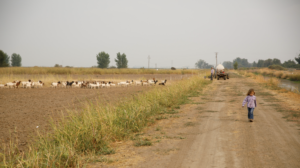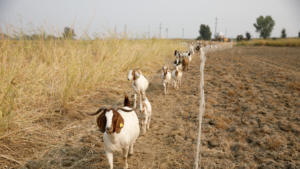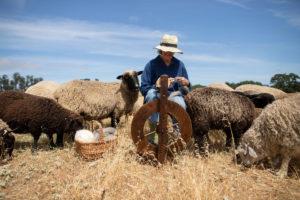Written by Marie Hoff

Paige Green Photography
Grazing and grain are ancient, connected in a relationship of survival that, through their mutual adaptation, support the varied and complex world that is life itself on this planet. Forged on grasslands and woodlands, and over millions of years, grasses — which produce grain — and livestock — who perform grazing — have grown together in a tight partnership. It’s one that clothes and feeds people and organisms in its processes, while stabilizing and harmonizing the planet’s rhythms and climate, its nutrient and water flow, with a balanced environment as a result.
People have stewarded this relationship in many parts of the globe as shepherds, thereby securing their fiber and food supply, while domesticating both grazing animals and grains in the process. Though plentiful in grassland and woodland areas, in California, Indigenous peoples have stewarded the grazing and grain relationship in a different way — a way that did not domesticate the grazers or the grasses. In burning and stewarding the fire ecology of the lands, grazers and grasses were also affected by these actions, such that they rendered seed and skin and meat, providing fiber, food, basketry materials, medicinal herbs, and assorted other materials necessary in life.
In California today, both these relationships to grain and grazing exist: Indigenous ways and shepherding based on primarily European traditions, with some modern influences. Grasslands in California are in danger today, and though they are the most prevalent ecosystem in the state, they are also the most imperiled. This article will look at different ways people have in the past, and are today, working to restore grassland health, and at the same time produce grain and grazing systems that provide both grains and fiber from these locally productive lands.
California is a fire-based landscape. Plants and animals and people have all adapted to it, in different ways, but always as a matter of course. Indigenous people have burned, and continue to burn, regularly in order to manage the fuel load of vegetation, as well as for a wide variety of different plant, animal, and landscape outcomes, such as proper basketry materials and seed production. The grasses expect it. When burned at the right time in the right way, they grow back to produce lush, green grass that attracts grazers such as elk and deer (making them easier to hunt). When grazed at the right time and in the right way, the grasses can grow back again and produce more plentiful grain for people to harvest. One story of this cycle lies in Malcolm Margolin’s book The Ohlone Way, in the chapter The Seed Meadow.

Paige Green Photography
While people are still able to burn some areas in the good ways, since European contact and the introduction of mainly European domesticated livestock, the native grazing and grain connection such as the one described in Margolin’s book has largely been decimated. These days, deer and elk graze in much smaller numbers, having a different impact than they once would have had in a herd of thousands. Highways and cities block their animal corridors and numerous other factors keep their numbers low. With the introduction of non-native and annual grasses, often imported on the hooves of those early livestock, native grass species have reduced in number across the state, replaced with species that are less deep-rooted and more fire-prone.
However, domesticated livestock, initially managed poorly, are now a positive way moving forward to maintain a grazing impact that may both reduce fuel load for wildfire, and steward the grazing-grain connection. While many Indigenous people continue to do traditional burning, today the desired effects are typically for fuel reduction and basketry materials and not seed harvest.
Through an assortment of different impacts on farming, grazing and grain are very often separate at this time. Whether food safety laws by CDFA, or water selling regulations by the State Water Board, or simple lack of standard practice in agriculture, raising plants while raising animals on the same field is highly limited. The concept of ICLS (Integrated Crop and Livestock System) is relatively new in academics and ag, despite the ancient relationship it describes. When applied, the resulting response from the health of the land to the production of fiber and food is promising. Let’s look at some different producers who are striking out to restore grazing and grain through their own creative and innovative means.
Farmer Mai Nguyen grows heirloom grain in Sonoma County, with local flours available through their own Flour Share and through small-scale flour mill Grist and Toll. They incorporate grazing in grain fields for an array of different purposes, from weed abatement to nutrient management to mowing in order to stimulate plant growth, even to systemic change of the agricultural economy itself. They note that, “if you’re grazing in order to stimulate grain production, that’s only how you think in a production commodity system. Whereas it makes more sense to think like an ecosystem, it’s all interconnected. Diverse ecosystem management is a core part of thinking about farming, it’s where veg and perennials come in, how healthy soils fit in, mycorrhizal functioning, but also things like shade for animals aboveground. Thinking like an ecosystem provides multiple benefits.”
They continue on to say, “I want everything to be as local as possible, including soil health and soil nutrients. In an organic system, you’re still often hauling compost from other places. Having animals that can process the nutrients and expedite the process of available nitrogen, distributing the fertilizer evenly, is ideal. Local includes fertilization. The timing of it works really well, when you graze it before the tillering stage, and at that stage is when the grain needs more nitrogen after it’s been mowed anyway.” Mai also grazes grain fields after harvest, to clear crop residue from the fields. These efforts work to return nutrient cycling back into a community context.
Ted Kingsley contracts his goats’ grazing services at Davis Ranch in Colusa, CA, reintegrating the benefits of their grazing for a collection of different purposes. The goats provide the usual weed abatement and fuel load reduction. But they also clear clogging vegetation from waterways and help reduce invasive plants in hard-to-access areas. And during the summer they graze down weeds and grasses in rice checks (a mounded earth boundary separating different rice fields and containing or directing water flow), supporting larger-scale rice production.
Typically, a fossil-fuel-driven mower would otherwise take care of this vegetation. Davis Ranch is involved in a carbon credit program for their carbon sequestering farm practices, the compensation of which goes to employ Ted and his goats. Ted’s approach is adaptive, each day he observes the goats, the vegetation, and the landscape. With those observations and with a desired outcome in mind, he moves the goat’s enclosure to best fit those needs, paying attention and learning as he goes. Because living systems, like farms, can be complex in their daily shifts and changes, Ted’s adaptive approach helps him to use the grazing power of the goats effectively. He and Davis Ranch are open and willing to experiment, trying the goats in different places and for different purposes, but always observing, reflecting, re-evaluating, and managing for overall landscape function. They don’t just replace fossil-fuel-driven machinery, they replace an approach that only considers the short term with a more holistic and dynamic system of management.

In 2019, Park Farming began trying out grazers instead of fossil-fuel mowers on their commercial-scale farm in Sutter County. The benefits, Scott Park realized, were numerous. The animals reduced labor, pesticide, and fuel costs by replacing the mowers, but their impact also left softer ground that was easier to plant into later on, reducing tractor expenses in the future. He notes that when animals pull on the plants, they stress the plants enough so the plants release more exudates (soil nutrients) through their roots and feed microbial life, but not when uniformly chopped with a machine. He also notices more earthworms on grazed ground, along with a sponge-like desirable quality to the soil. Animals graze wheat, rice, corn, and tomatoes.
In the end, the profit has to be there for Scott to continue to farm, and he’s had good results integrating grazers. Scott contracts out the grazing to a local grazing operation, Kaos Sheep Outfit, while selling his crops on the commercial market. The wool from Kaos Sheep Outfit is also typically sold on the commercial market, with some brand-specific direct sales occasionally popping up. Their sheepskins are available through Shepherdess Holistic Hides.
Linda Gamble raises her three Shetland sheep on a two-acre home site in West Sonoma County, while also dry farming two varieties of wheat. If you’re noticing a trend of observation, evaluation, and readjustment from the producers covered thus far, Linda is no exception. She tends to the wheat while enveloping her sheep into the plant’s life cycle. The wheat provides good nutrition for the sheep in the winter and early spring. The wheat seeds that go back onto the ground are then nourished by sheep droppings and straw, the dung and straw combo used for the purpose of feeding fungal and bacterial communities in the soil, while the wheat grows aboveground. Straw remains are then used as mulch to prevent invasive plants from growing. Linda uses the word acquainted when talking about her wheat, as in “Wheat is an interesting plant to get acquainted with,” affirming the relational quality between people, plants, and animals. Linda uses the wheat herself and spins and knits her sheep’s wool into delicate, intricate creations.
The relationships between grain and grazing are not just ancient, they are diverse. These are just some of the producers reworking animal and plant integration in California, with many others forging their own way. At the heart of it lies mutual survival. At the edges lay a better way to live.
References
- Additional people consulted for this article include Redbird, CA Native and a Land Manager at Heron Shadow Farm in Graton, CA, Phil Lanham, a farmer of grain and cattle in Potter Valley, CA, and Rachel Britten from Mendocino Grain Project.
- https://nonprofitquarterly.org/fire-forests-and-our-lands-an-indigenous-ecological-perspective/
- Malcolm Margolin’s Ohlone Way
